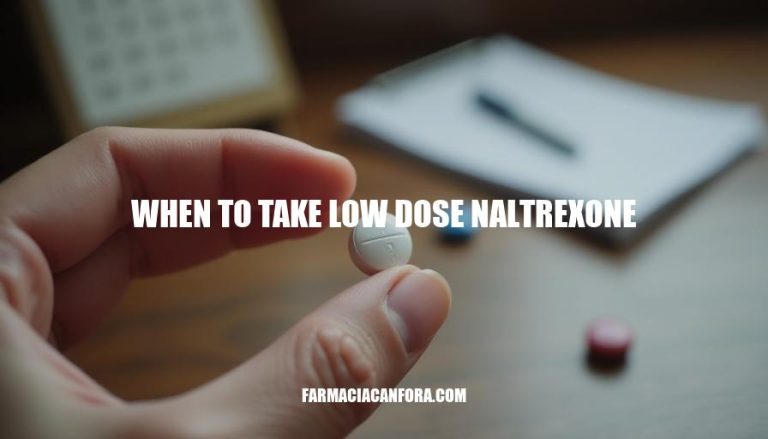


Low dose naltrexone is a medication that’s getting attention in the medical world for its potential to help with various health issues. It was originally made to treat opioid and alcohol addiction, but now people are looking into how it can be used at lower doses. When taken in small amounts (1.5-4.5 milligrams), LDN seems to calm down the immune system and reduce inflammation without causing many side effects.
Low dose naltrexone (LDN) is typically taken at bedtime, around 9 PM to 10 PM, to ensure it is absorbed properly and to minimize potential side effects. The standard starting dose is 0.5 mg, taken daily for two weeks, followed by a gradual increase of 0.5 mg every two weeks until reaching a dose of 4.5 mg or the highest tolerated dose. For some conditions, such as chronic pain or autoimmune diseases, doses up to 10 mg daily may be used.
It is important to avoid taking LDN with opioid medications, as it can precipitate withdrawal symptoms.
Additionally, individuals with a history of opioid dependence or recent opioid use should wait at least 7 to 10 days after their last opioid dose before starting LDN.
For patients with liver conditions, LDN should be used with caution, and regular monitoring of liver function is recommended. Those with acute hepatitis or severe liver impairment should consult their healthcare provider before starting LDN.
In clinical studies, LDN has shown promise in treating conditions such as fibromyalgia, Crohn’s disease, multiple sclerosis, and chronic pain by modulating neuro-inflammation and reducing symptoms. However, it is important to note that LDN is not FDA-approved for these conditions and should be used under the guidance of a healthcare professional.
Overall, LDN should be taken consistently at the same time each day, and any changes in dosage should be made gradually and under medical supervision.
When it comes to taking Low Dose Naltrexone (LDN), consistency is key. The medication should be taken at the same time each day, ideally around 9 PM to 10 PM, to ensure proper absorption and minimize potential side effects. It’s essential to follow a healthcare professional’s guidance when starting LDN, as they will help determine the best dosage for your individual needs.
The standard starting dose is 0.5 mg, taken daily for two weeks, with gradual increases of 0.5 mg every two weeks until reaching a dose of 4.5 mg or the highest tolerated dose. However, some conditions may require higher doses, up to 10 mg daily.
It’s crucial to note that LDN should not be taken with opioid medications, as it can precipitate withdrawal symptoms. Individuals with a history of opioid dependence or recent opioid use should wait at least 7 to 10 days after their last opioid dose before starting LDN. Additionally, those with liver conditions should use caution and have regular monitoring of liver function.
While LDN has shown promise in treating various conditions such as fibromyalgia, Crohn’s disease, multiple sclerosis, and chronic pain by modulating neuro-inflammation and reducing symptoms, it is essential to remember that LDN is not FDA-approved for these conditions. As with any medication, individual results may vary, and treatment plans should be tailored to each person’s specific needs.
Ultimately, the benefits of taking LDN lie in its potential to reduce inflammation and calm down the immune system without causing significant side effects. With proper guidance from a healthcare professional and consistent adherence to treatment, LDN may offer relief for those struggling with chronic conditions.